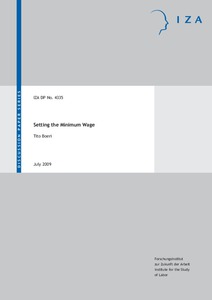Setting the minimum wage
"The process leading to the setting of the minimum wage so far has been fairly overlooked by economists. This paper suggests that this is a serious limitation as the setting regime contributes to explain cross-country variation in the fine-tuning of the minimum wage, hence in the way in which t...
| Main Author: | |
|---|---|
| Institution: | ETUI-European Trade Union Institute |
| Format: | TEXT |
| Language: | English |
| Published: |
Bonn
2009
IZA |
| Subjects: | |
| Online Access: | https://www.labourline.org/KENTIKA-19187338124919055109-Setting-the-minimum-wage.htm |
| Summary: | "The process leading to the setting of the minimum wage so far has been fairly overlooked by economists. This paper suggests that this is a serious limitation as the setting regime contributes to explain cross-country variation in the fine-tuning of the minimum wage, hence in the way in which the trade-off between reducing poverty among working people and shutting down low productivity jobs is addressed. There are two common ways of setting national minimum wages: they are either government legislated or are the outcome of collective bargaining agreements, which are extended erga omnes to all workers. We develop a simple model relating the level of the minimum wage to the setting regime. Next, we exploit a new data set on minimum wages in 66 countries that had already or introduced a minimum wage in the period 1981-2005 to test the implications of the model. We find that a Government legislated minimum wage is lower than a wage floor set within collective agreements. This effect survives to several robustness checks and hints at a causal relation between the setting regime and the level of the minimum wage." |
|---|---|
| Physical Description: | 28 p. Digital |

